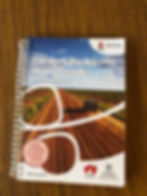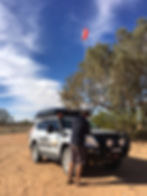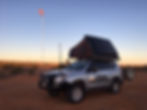Top 10 essentials for crossing the Simpson Desert
- Trekking Downunder
- Aug 19, 2019
- 8 min read
Updated: Nov 13, 2020

The biggest requirement for any remote overland travel, especially crossing the Simpson Desert is you have to be prepared. On our recent two way (east and west) solo vehicle crossing of the Simpson Desert we put together a top 10 essentials list to ensure all the safety and comfort aspects of our trip would be considered and covered before we left.
Below are our top 10 essential items for crossing the Simpson Desert
Satellite telephone (and/ or with) an epirb
Satellite telephone - A sat phone is an absolute must for any remote outback travel where there is limited to no reception. Heads up- The Simpson Desert is a complete black spot for all major and minor Mobile phone carriers. A Sat phone connects to the relevant satellite network you are signed up to and can connect almost anywhere world wide. We use a Garmin Inreach unit which although is unable to make calls, it can send and receive text messages, emails and is a registered epirb.

The idea behind the epirb is the comfort of instantly contacting emergency services from anywhere, in the event of a serious emergency and it’s handy when it’s all in the single unit. During peak periods of crossing, you will regularly pass other vehicles who will often be able to help, but depending on the situation it may be in a restricted capacity. What you need to be prepared for is a situation when medical services are required immediately or as soon as possible.
To learn more about the inreach range click here
SA Desert Parks Pass and Handbook
You will receive the two when purchasing your Simpson permit along with a deserts park paper fold out map. You must have your Deserts Park Pass and Handbook when travelling the Simpson Desert (and others) and produce both if requested by a ranger. The pass last’s 12 months and in non-transferable as it is specific to your vehicle. The permit pass allows you (multiple) park entries and camping, the handbook is a complete resource on all you could possibly need to know for your trip.

The handbook covers; conditions of entry, travel requirements and recommendations, estimated travel times, basic first aid, safe desert driving tips, track, animal and camping info and important information about the local aboriginal communities. Each National Park is broken down into sections and further specific information provided. The handbook is completely invaluable and we would recommend have a very good read over the information before heading into the crossing- there is plenty of common knowledge information but also many other unique points you may not have considered before.
To purchase your permit click here
Sand flag
As a mandatory requirement of entry, each vehicle must ensure to have a sand flag on the car. A sand flag needs to be 3.5m from the ground and have a high visibility flag on top in fluorescent red orange or fluorescent lime yellow.
You will need a flag to be your point of visibility to oncoming vehicles. When cresting a dune or even short tight level section, your Sand Flag will be what others often sight first before your vehicle. If you haven’t had adequate radio communication ahead, it could be the only thing that prevents a head on collision in low visibility areas like when cresting sand dunes.

Can you make your own? Sure, but you need to use a strong suitable rod-like material as a flag pole, attach it very securely to your vehicle, ensure it meets the standard regulations and be sure your flag is secured correctly so it doesn’t come off or tangle in any over head trees.... the best safest option is to purchase a regulation flag from a reputable reseller.

We use a ‘Bushranger 4x4 Gear sand flag with supplied bull bar mount, its flex, height and durability was extremely impressive on the dunes of the Simpson.... We found it to be the tallest of all the flags on the track and this made us feel very visible at the crest of each dune.
UHF set on channel 10
A UHF radio is a highly recommended item to have for a Simpson Crossing- although not mandatory. Having driven the Simpson Desert twice in 7days, we strongly agree it will make your trip safer and you’ll feel much more confident cresting the some 1,100 sand dunes. We use a GME unit and the device was perfect for communication with oncoming convoys, when hoping to overtake a group or slower vehicles, to alert or receive information on dune hazards, to give and receive acknowledgement with other travellers (etc). Due to its versatility a UHF is such a valuable tool to utilise in such a variable visibility area.

To see GME's full range of UHF's click here.
Fuel/ jerrycans
Sufficient fuel is a calculated consideration you need to make before heading into the Simpson. If you have a long range tank (depending on its capacity) you might have no need for jerrycans, but if you have a limited capacity you need to do some research on distances V the fuel consumption of your vehicle to ensure you are well prepared before hitting the dunes. The Simpson is sandy, and at time rough dune driving with periods of flat sections. The Handbook states from Birdsville to Mt Dare is 510km (Eyre Creek Bypass omitted which is a further approx 68kms on top) and approximately just over 26hrs of driving. Make sure to take into consideration if your common calculations are for when your are towing or if your usually highway driving.

With the Simpson Track requiring 4WD and low range you will use higher than normal fuel and the rule of thumb we seem to encounter is double you normal track fuel consumption. We personally found that this would be excessive for us, we have a 150L factory fitted long range full tank and we also carried 2x 20L jerrycans giving us 190L of Diesel. We only used 111L to get over to Mt Dare from Birdsville taking the French Line and 149L to return back East via the WAA, Rig Rd and K1. If you’re unsure and can manage the weight- ere on the side of ‘more is safer’. Be aware fuel at Mt Dare is going to be at minimum $2.45/L and it is usually sitting about $1.75/L in Birdsville.

Tip; keep to the bare necessities when packing the car, as the lighter your vehicle the lower your fuel consumption will be.
Water
Its simple really, one of the most important survival aids in the desert is water, you should aim carry as much water as you possibly can. It is recommend you should carry at least 7-10L per person/per day and the latter as a minimum in the hotter months according the RFDS. You should account for enough water to cover drinking, cooking and some limited washing. If you have external tanks, where possible it is advisable to have multiple tanks in the event one tank is punctured you could loose your entire water supply. We run an ORS internal 45L water tank that sits between out back seats and the cargo barrier. Mt Dare and Birdsville both have either access to tap water or sell boxed water.
Recovery gear (sand tracks, snatch strap and shovel)
Sand track recovery aids are one of the best items you can keep in your kit. There are two main options when looking at these types of aids being a hard plastic version such as the Maxtrax and a compact rubber rolled version such as those from Bushranger 4x4 gear. The benefits of the hard plastic versions are that they can be used as a shovel and are often easy to mount to roof racks. The rolled rubber versions whilst not being as versatile worked a treat for us as we have no available storage space on the roof.

Snatch straps are another must have item when crossing the desert. There are often travellers spread across the various tracks who will be only too happy to help snatch you out if you get stuck with your strap and shackles. Be sure to have an appropriately rated strap for your setup and we strongly recommend using a damper blanket if possible to help prevent damage and injury if something were to go wrong.
A shovel is a very multipurpose item that can be used in a number of desert situations, from recovery to daily use. A shovel can be your most valuable tool if required to dig yourself out should your vehicle become stuck, the most common type of inconvenient situation people encounter in the Simpson. A shovel is an extremely handy tool used to help maintain and to extinguish your camp fire, also move around hot coals for cooking. And lastly it is a MUST when digging a hole for your outback bush toilet needs. Just add a box of matches and a roll of toilet paper and your impact on the desert environment will be extremely minimised, helping protect the beautiful pristine arid lands.

You can use a long handle shovel (pictured above) and securely mount it to the roofrack or choose a compact folding shovel that can be placed anywhere within your set up.
Good quality tent/swag with warm bedding and appropriate clothing
During the winter months is the most common time to cross the Simpson and it should be noted the nights are really bitter and often zero degrees and below. Ensure you have an adequate roof top tent, tent (with decent sand pegs) or swag with you and set yourself up with very warm and comfortable bedding. We used our iKamper roof top tent and had all 5 of us spread across the king sized mattress. We packed our quilt and extra fleece blankets and sleeping bags for our kids, we still needed beanies and jumpers to sleep at night and also each morning.


During the days it was cooler when we were heading west and warmed up on our trip back east. We chose to drive from early morning (around 8-8.30am onwards QLD time) to avoid the bitter chill and pull up earlier in the afternoon to enjoy the warmer temperatures (around 3.30pm QLD time). Long sleeve shirts (and jumpers) helped with cooler weather but also the suns rays. Flies weren’t too extreme (until Dalhousie Springs for us) but some might like to pack their fly nets in case.
Food (cooking appliances/ fire wood)
If your travelling with a fridge in your vehicle you will find it easier to bring a variety of foods for the trip. Pack for about 4 full days minimum, incase you encounter a delay. Ensure you have food to not only cover the 3 main meals each day but also in between meals for the car (esp if crossing with kids). You will spend majority of your time in the car driving, so have plenty of easy and nutritious snack food on hand.
We took a little portable burner and our small saucepan set for dinners but also used our spun steel pan with campfires where permitted.
We kept it fairly simple, cereal and shakes for breakfast, salad wraps at lunch stops and then we enjoyed a variety of dinner meals. Keeping it simple not only helped when stocking the car pantry and fridge, but it also kept our need for utensils/pans/plates (etc) and water for washing up much more minimal.

Wheelie bin bag
A portable rubbish bin/ gear bag- This one has made the essentials list as the Simpson Desert and surrounding National Parks have no rubbish collection facilities. You must collect all of your rubbish and take it with you to drop at the garbage tips located at each end of the track, one on the way to Dalhousie and one on the way into Birdsville.
Burning rubbish in a campfire is not acceptable nor is it guaranteed to remove all waste, and it is illegal to dump it in the bush. So do the right thing, bag it up and chuck it into a wheelie bin until you get to the tip at the end of your trip.

We use a Bushranger 4x4 Gear wheelie bin/ gear bag and it was perfect for the Simpson because this Wheelie Bin is a sturdy PVC bag and comes with a centre divider. We filled one side with rubbish bags and then one side with fire wood (as collection is limited). We use a large garage bag liner and then tie up any smaller bags to keep contents from leaking or spoiling in the bottom of the bin or being an attraction to the wildlife, plus this also makes it easier to empty the entire bag in one go.
If you enjoyed reading our Simpson Desert Essentials then check out our recent article on Safe Ouback Driving Travel Tips.
If you have any questions or would like to get in touch we would love to hear from you. 'Contact Us'

